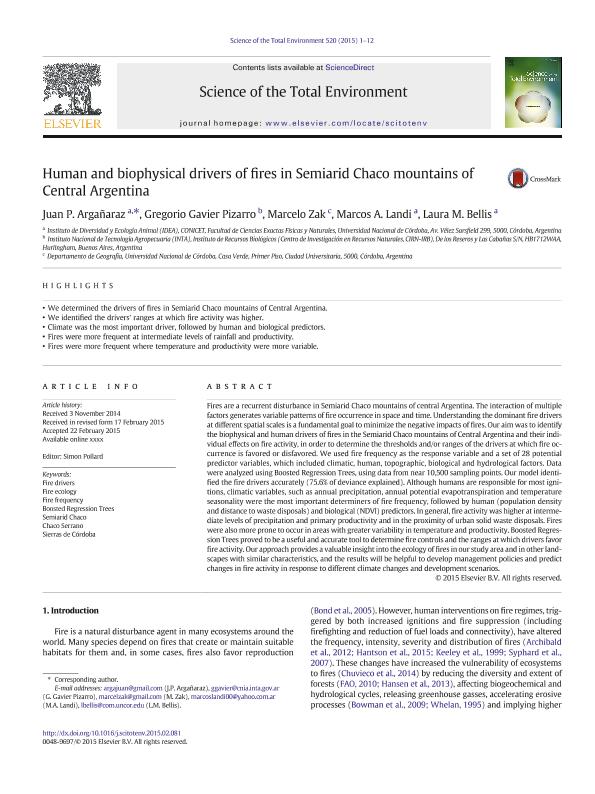Artículo
Human and biophysical drivers of fires in Semiarid Chaco mountains of Central Argentina
Argañaraz, Juan Pablo ; Gavier Pizarro, Gregorio; Zak, Marcelo Román
; Gavier Pizarro, Gregorio; Zak, Marcelo Román ; Landi, Marcos Alejandro
; Landi, Marcos Alejandro ; Bellis, Laura Marisa
; Bellis, Laura Marisa
 ; Gavier Pizarro, Gregorio; Zak, Marcelo Román
; Gavier Pizarro, Gregorio; Zak, Marcelo Román ; Landi, Marcos Alejandro
; Landi, Marcos Alejandro ; Bellis, Laura Marisa
; Bellis, Laura Marisa
Fecha de publicación:
07/2015
Editorial:
Elsevier Science
Revista:
Science Of The Total Environment
ISSN:
0048-9697
Idioma:
Inglés
Tipo de recurso:
Artículo publicado
Clasificación temática:
Resumen
Fires are a recurrent disturbance in Semiarid Chaco mountains of central Argentina. The interaction of multiple factors generates variable patterns offire occurrence in space and time. Understanding the dominantfire drivers at different spatial scales is a fundamental goal to minimize the negative impacts offires. Our aim was to identify the biophysical and human drivers offires in the Semiarid Chaco mountains of Central Argentina and their individual effects onfire activity, in order to determine the thresholds and/or ranges of the drivers at whichfire occurrence is favored or disfavored. We usedfire frequency as the response variable and a set of 28 potential predictor variables, which included climatic, human, topographic, biological and hydrological factors. Data were analyzed using Boosted Regression Trees, using data from near 10,500 sampling points. Our model identified thefire drivers accurately (75.6% of deviance explained). Although humans are responsible for most ignitions, climatic variables, such as annual precipitation, annual potential evapotranspiration and temperature seasonality were the most important determiners offire frequency, followed by human (population density and distance to waste disposals) and biological (NDVI) predictors. In general,fire activity was higher at intermediate levels of precipitation and primary productivity and in the proximity of urban solid waste disposals. Fires were also more prone to occur in areas with greater variability in temperature and productivity. Boosted Regression Trees proved to be a useful and accurate tool to determinefire controls and the ranges at which drivers favor fire activity. Our approach provides a valuable insight into the ecology offires in our study area and in other landscapes with similar characteristics, and the results will be helpful to develop management policies and predict changes infire activity in response to different climate changes and development scenarios.
Archivos asociados
Licencia
Identificadores
Colecciones
Articulos(IDEA)
Articulos de INSTITUTO DE DIVERSIDAD Y ECOLOGIA ANIMAL
Articulos de INSTITUTO DE DIVERSIDAD Y ECOLOGIA ANIMAL
Citación
Argañaraz, Juan Pablo; Gavier Pizarro, Gregorio; Zak, Marcelo Román; Landi, Marcos Alejandro; Bellis, Laura Marisa; Human and biophysical drivers of fires in Semiarid Chaco mountains of Central Argentina; Elsevier Science; Science Of The Total Environment; 520; 7-2015; 1-12
Compartir
Altmétricas



